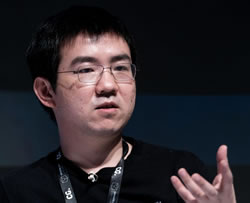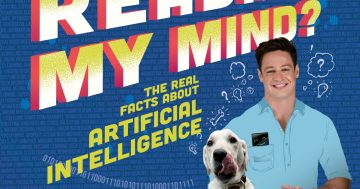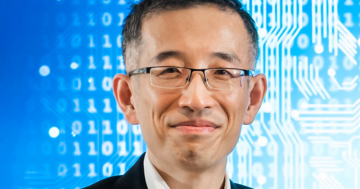At Cortical Labs, CEO Hon Weng Chong and his team have trained human brain cells on a computer chip to play the classic video game Pong. Chong is now spreading out says Zinnia Lee
 Hon Weng Chong got a Christmas surprise last year when AmazonAMZN -0.6% called and said its chief technology officer wanted to visit Cortical Labs’ base in Melbourne.
Hon Weng Chong got a Christmas surprise last year when AmazonAMZN -0.6% called and said its chief technology officer wanted to visit Cortical Labs’ base in Melbourne.
The CTO of the world’s largest cloud provider, Werner Vogels, was intrigued by the four-year-old startup’s sci-fi innovation: A living human brain cell-powered computer chip, dubbed DishBrain, that has learned to play Atari’s Pong game while apparently using energy equivalent to a pocket calculator.
“Werner told us the biggest cost out of any data centre or cloud provider is the energy that they pay for running the equipment and cooling the system,” recalls Chong, cofounder and CEO of Cortical Labs.
“And we have a system that consumes hardly any energy and outputs very little heat. The unit economics completely flips on its head, especially if you can start training it to do AI tasks.”
Training lab-grown living brain cells atop a chip to play the tennis-like video game is just the start. By combining the extraordinary learning ability of human brains and the processing power of silicon chips, Chong is building biological computers that he claims could potentially work smarter and more efficiently than today’s AI.
The 35-year-old doctor-turned-entrepreneur is commercialising the innovation, hoping that it could one day upend various applications—from testing novel drugs for brain diseases to slashing the enormous energy bill for training AI.
“Ultimately, the goal for Cortical Labs is to be like Nvidia, which is to enable the creativity of other users to build on this technology,” Chong says in a video interview from his office in Melbourne.
“In five years, we’d love to have five, 10 successful companies or startups running their own businesses, but built using our technology.”
In April, Cortical Labs netted $10 million in a funding round led by Horizons Ventures, the private investment arm of Hong Kong’s richest person Li Ka-shing.
Joining the round was existing investor Blackbird Ventures, one of Australia’s largest venture capital funds, as well as In-Q-Tel, the venture capital arm of the Central Intelligence Agency, among others.
Armed with fresh capital, Cortical Labs aims to start generating revenue by the end of this year when it kicks off sales of its biological computers. The company has already signed up Bit Bio, a spinoff of the University of Cambridge that provides human cells for research, to experiment with its product, says Chong.
And by the end of 2024, Cortical Labs will start to provide cloud services, having clusters of 120 biological computers for companies to program brain cells for different tasks, he adds.
Chong reveals Cortical Labs is in negotiations with several U.S. cloud providers to plug in its services.
To be sure, Chong faces a tall task.
Scientists have been trying to fuse living cells with silicons for two decades, hoping they could build an AI system that works like a human brain while advancing applications in medicine and other fields.
Back in 2004, a biomedical engineer from the University of Florida said he had trained rat brain cells arranged over a grid of electrodes to control an F-22 jet flight simulator. Yet, no one has so far succeeded in building a biological computer that could even compete with a conventional one.
Cortical Labs has already gone further than most in trying to commercialise biological computers.
A rare example is Koniku, a California-based company that combines living cells with computer chips to create sensors mimicking sniffer dogs’ ability to detect explosives and drugs. It has partnered with European aircraft maker Airbus to deploy its devices for aviation security.
But not everyone is impressed.
Playing Pong is something that a high-school calculator could do decades ago, notes Madeline Lancaster, a researcher at the Laboratory of Molecular Biology in Cambridge who pioneered lab-grown mini human brains.
“Neurons (the information messengers inside human brains) in a dish seem to be stuck, without major improvements in their computing power in 20 years,” she says in a written response.
“How exactly Cortical Labs plans to get past that barrier, and enable the same kind of exponential increase that was needed for computers, is unclear, so it is hard for me to see real feasibility yet.”
Apart from technical hurdles, Cortical Labs is also facing ethical questions—whether the lab-grown brain cells will become conscious, if they can feel pain and pleasure, and so on and so forth. The company has said its brain cells are “sentient,” which it defined as being “responsive to sensory impressions.”
Chong says Cortical Labs has been working closely with bioethicists and will continue to engage in conversation with society on ethical concerns. As for the technical side, however, Chong admits there’s a “humongous technical moat” for anyone to enter the space and that the field is full of uncertainties.
“It’s very difficult at Cortical Labs because not only do we have to be the Nvidia to make the hardware, but also be the OpenAI to write the software,” says Chong.
“On top of that, we have to prove that this biological computer can still extend further, that we can make it do more tasks than just playing Pong.”
Cortical Labs’ biological computer is “a body in a box,” Chong jokes.
The human brain cells are created by engineering stem cells from adults’ skin or blood. They are then integrated into a chip and placed inside a big shoe box-like device, which comprises a system to supply the cells with nutrients and air, and remove waste from them.
The brain cells essentially act like the central processing unit (CPU) of a conventional computer, Chong adds.
To train the brain cells for Pong, Cortical Labs connected the hybrid chip with a computer running the video game. The computer would send electrical signals revealing where the bouncing ball was and how far it was from the paddle.
The cells made its own decision on how to move, and learned to improve its performance through feedback from electrical signals.
Chong says Cortical Labs’ biological computer could help test the efficacy and side effects of drugs targeting neurological disorders, such as dementia and epilepsy. This could be done through the human brain cells’ performance in programs like Pong, he says.
The former doctor hopes to work with pharmaceutical companies like BiogenBIIB -3.2% and Eli Lilly to replace animals with human cells in drug tests.
“In the short-term, Cortical Labs’ biological computer brings forth compelling in-vitro solutions that can give further insight into how drugs affect neurons,” Jonathan Tam, an investor at Cortical Labs’ backer Horizons Ventures who leads AI-related investments, says in a written response.
“In the long-term, these synthetic neurons will offer unprecedented insight into how our brains function, which will unlock pathways into treating neurological disorders that were previously unsolvable.”
Cortical Labs’ biological computer can also help with a more grounded issue: High electricity bills.
Chong says biological computers could significantly cut the energy cost for training AI, which requires a great deal of electricity using cloud computing as it needs to read through mountains of data.
It also requires lots of cooling to keep the learning process going.
Training GPT-3, the brain behind OpenAI’s viral chatbot, for example, consumed 1.287 gigawatt-hours of electricity, according to a 2021 research paper. This equals to electricity consumed by around 120 homes in the U.S. in 2021.
The human brain, on the other hand, is said to run on about 20 watts, or the energy enough to power an LED light bulb.
With Cortical Labs’ innovation, cloud computing platforms for AI could cut energy consumption by “the order of magnitude of 10 to the power of six to eight watts,” Chong claims.
“The hope really is that with this kind of technology, energy will no longer be a bottleneck,” he says. “It’s potentially more sustainable as well because we’re not feeding the brain cells with electricity, but with simple sugars – glucose – as a compound.”
It’s not the first time Chong pursued an ambitious project. When he was a student at Melbourne Medical School, he developed a low-cost stethoscope that could plug into a smartphone, after seeing the need for diagnosis in places with scarce healthcare resources.
After graduation and a short stint as a doctor, Chong in 2014 picked up the idea again and cofounded CliniCloud to commercialise a digital stethoscope that allows anyone to take readings at home and consult doctors online.
The medtech startup received funding from the likes of Chinese tech giant Tencent, as well as the venture arm of Chinese financial conglomerate Ping An.
Yet, a lack of health consciousness before Covid, coupled with the uncertainty under former President Donald Trump’s administration to overhaul the U.S. healthcare system, killed CliniCloud’s business in 2018.
“ClinicCloud was way ahead of its time. Had we survived a couple more years, we would have really taken off because of the pandemic,” says Chong. “In fact, I had a lot of people calling me at the start of the pandemic asking me for thermometers and stethoscopes, and literally writing me a blank check.”
By then, Chong had already kicked off his AI pivot.
Inspired by a research paper by Alphabet-owned Google DeepMind, Chong cofounded Cortical Labs in 2019 with Andy Kitchen, the former head of AI research at CliniCloud.
The startup’s futuristic vision to build an AI system using human brain cells drew a A$1 million ($673,000) seed investment from Blackbird Ventures, followed by a S$1.2 million ($895,000) extension round from investors including Singapore-based January Capital.
Now, amid the AI craze, Chong is busy getting Cortical Labs’ biological computers into production.
He says he gets inquiries from companies asking what else the brain cells can do.
One of the inquiries was “ludicrous,” which was whether the cells could learn to trade bitcoin, Chong says with a laugh.
As crazy as it sounds, Chong didn’t dismiss the idea.
Instead, he offered to build a software code so that the inquirer could feed the brain cells with bitcoin prices and experiment.
“If it works, this is great. This is your technology, this is your IP. Go make a lot of money that way,” Chong says. “We shouldn’t be outright dismissive because a lot of ideas start out sounding really stupid, but you never know where it could go.”
* Zinnia Lee is the reporter and multimedia producer for Forbes Asia, based in Hong Kong.











